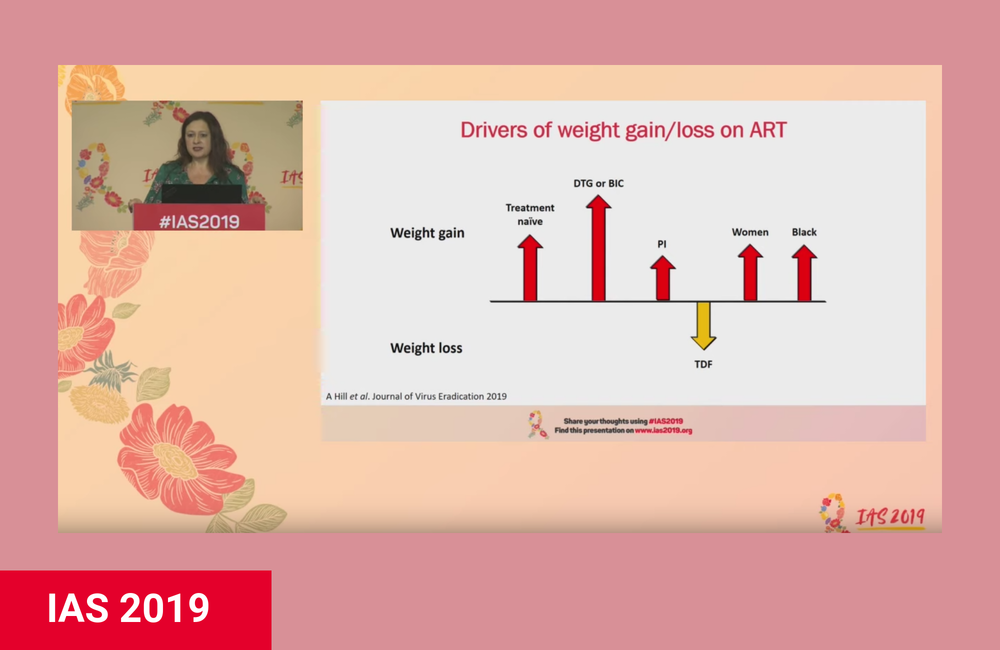
Treatment with dolutegravir resulted in weight gain for participants in two large clinical trials in sub-Saharan Africa and was especially pronounced when dolutegravir was combined with the new formulation of tenofovir (tenofovir alafenamide fumarate, TAF), Dr Michelle Moorhouse of Wits Reproductive Health Institute, Johannesburg, reported at the 10th International AIDS Society Conference on HIV Science (IAS 2019) in Mexico City on Monday.
In both studies, women gained more weight than men.
Dolutegravir is a highly potent HIV integrase inhibitor that is recommended for first-line antiretroviral treatment in all major treatment guidelines. At the conference, the World Health Organization unveiled updated guidelines recommending the use of dolutegravir in the treatment of all adults.
Since dolutegravir (Tivicay) received marketing approval in the United States and European Union in 2013, several side-effects have become apparent in cohort studies.
Central nervous system side-effects such as insomnia, anxiety, depression and dizziness have been reported at higher levels than in the studies which led to marketing approval.
Neural tube defects in infants exposed to dolutegravir at the time of conception or in the first three months of pregnancy have been observed at a higher frequency compared to other infants exposed to other regimens in an observational study in Botswana, but this safety signal has not shown up in reviews of cohorts in other countries.
Weight gain associated with the integrase inhibitor dolutegravir has been observed in several large cohort studies but evidence from randomised clinical trials has been less clear-cut.
Weight gain after starting antiretroviral treatment is common but substantial weight gain may increase the risk of adverse birth outcomes, diabetes, cardiovascular disease and some cancers. Clinical obesity, defined as body mass index (BMI) greater than 30 has been shown to reduce life expectancy by four years.
Dr Andrew Hill of the University of Liverpool and fellow investigators analysed weight gain after starting dolutegravir-based treatment compared to efavirenz-based treatment in two clinical trials conducted in sub-Saharan Africa.
NAMSAL study
The NAMSAL trial randomised 613 adults in Cameroon to either the older formulation of tenofovir (tenofovir disoproxil fumarate, TDF), lamivudine and dolutegravir or tenofovir, lamivudine and efavirenz. Participant body weight was measured at baseline and at week 48.
The study population was approximately two-thirds female with a median BMI of 23 (IQR 21-26). Thirty per cent of participants had a very high baseline viral load (> 500,000 copies/ml).
After 48 weeks, participants in the dolutegravir arm of the study had gained a median of 5kg compared with a 3kg gain in the efavirenz arm (p < 0.001). BMI increased by +1.7 in the dolutegravir group and +1.2 in the efavirenz group (p < 0.001). There was no difference in the proportions who gained enough weight to be classified as overweight (BMI >25) but a significantly higher proportion of the dolutegravir group gained enough weight to be classified as obese (BMI >30) (12 vs 5%) (p < 0.01).
Weight gain of greater than 10% of body mass was significantly more likely to occur in women taking dolutegravir (44 vs 34%, p < 0.05) when compared to efavirenz, but there was no significant difference in weight gain by regimen in men (26 vs 19%).
On the other hand, the emergence of obesity on treatment differed by regimen only in men, with dolutegravir once more associated with greater weight gain (14 vs 2%, p < 0.01).
ADVANCE study
The ADVANCE study randomised 1053 adults and adolescents in South Africa to either tenofovir disoproxil fumarate (TDF), emtricitabine and dolutegravir; tenofovir alafenamide fumarate (TAF), emtricitabine and dolutegravir; or TDF, emtricitabine and efavirenz. Participant body weight was measured at baseline and every 12 weeks. A sub-study used DEXA scans to measure limb fat at baseline, week 48 and week 96.
A majority of the study population were women (57 to 61% by study arm) and women had higher mean body weight and higher BMI than men (male BMI 21.7, female BMI 25.6-26.1). Approximately 35% of participants were either clinically overweight or clinically obese.
After 48 and 96 weeks, weight gain was greatest in the TAF/emtricitabine/dolutegravir arm (+6kg, +8kg). Weight gain was lower in the TDF/emtricitabine/dolutegravir arm (+3kg, +5kg) and lowest in the TDF/emtricitabine/efavirenz arm (+1kg, +2kg).
Similarly, the proportion who became clinically overweight or clinically obese was greatest in the TAF/emtricitabine/dolutegravir arm. By 96 weeks, 19% in the TAF arm had become clinically obese, compared to 8% in the TDF/emtricitabine/doltegravir arm and 4% in the efavirenz arm (p < 0.01).
In the ADVANCE study, there was a significant difference in weight gain by gender. Men and women randomised to dolutegravir gained weight to a similar extent up to week 48, but whereas male weight stabilised after week 48, women continued to gain weight.
Clinical obesity emerged more frequently in women during the follow-up period, especially in women randomised to tenofovir alafenamide. In the TAF arm, 20% of women became clinically obese by week 48 and 23% by week 96, compared to 8% of men at weeks 48 and 96.
Body composition analysis by DEXA scan showed that just over half the weight gained by men in the dolutegravir arms was fat and this was evenly distributed between trunk and limbs. In women, DEXA scans showed that around two-thirds of the weight gained in the dolutegravir arms was fat, again evenly distributed between trunk and limbs.
Multivariable analysis which controlled for demographic factors, baseline BMI, viral load and CD4 count, concomitant medications and history of diabetes, hypertension and elevated cholesterol, showed that treatment-associated obesity was associated with treatment with TAF/emtricitabine/dolutegravir, baseline viral load or CD4 count and baseline BMI. A weight gain of 10% or more was associated with treatment with TAF/emtricitabine/dolutegravir, baseline viral load or CD4 count, female sex and baseline weight.
However, when 68 participants in the ADVANCE study were asked about their perceptions of weight gain, few complained. Eight out of 51 women expressed unhappiness, although only four had gained more than 10% of body weight. In some cases, participants in the study viewed their weight gain as a sign of a return to health, even when they had not been underweight, or experienced weight loss prior to starting treatment. For many participants interviewed, the main consequence of weight gain was the need to buy new clothes as their pre-treatment clothes did not fit anymore.
Longer-term follow-up is needed to evaluate the consequences of weight gain in these study populations. Follow-up of the ADVANCE study participants will continue for a further two years, but analysis of other trial populations is needed to look at weight gain in different settings and populations, said Moorhouse.
Hill A et al. Progressive rises in weight and clinical obesity for TAF/FTC/DTG and TDF/FTC/DTG versus TDF/FTC/EFV: ADVANCE and NAMSAL trials. 10th IAS Conference on HIV Science, Mexico City, abstract MOAX0102LB, 2019.

